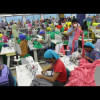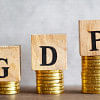Economy growing but trade-GDP ratio falling gradually

https://www.thedailystar.net/business/news/gdp-grows-71-falls-below-provisional-data-3239866Bangladesh's exports and imports as percentage of its gross domestic product (GDP) has been falling gradually, although the economy has continued growing by 6.5 percent annually in the last one decade.
The ratio of import to GDP, which was 21.2 percent in 2013-14 fiscal year, halved to 10.69 percent in 10 years.
The ratio of export to GDP even experienced a sharper fall, from 17.2 percent a decade ago to 7.66 percent in FY23, according to data by Bangladesh Economic Review 2023.
As a result, share of Bangladesh's international trade to its growing economy has halved in the past one decade, raising questions about the credibility of national income estimates.
At the same time, the falling ratio of exports and import also shows Bangladeshi entrepreneurs' lack of appetite to try their products in the international market through exports, two analysts said last week.
"Behind the drop, one reason could be that our industrialisation strategy is inward looking. There is high tariff protection for domestic market-oriented industries that prevent entry of foreign products. This makes profits from business from domestic market protected," said Zahid Hussain, former lead economist at the World Bank Dhaka.
So, naturally entrepreneurs will be interested to invest for domestic market in lieu of competing for selling their products in the international market, he said.
"Return on capital is much higher in doing business locally than exporting."
The maiden national tariff policy published this week showed that the customs authority has cut Bangladesh's average tariff protection rate from over 70 percent two decades ago.
During the FY23, average tariff protection rate was 30.58 percent.
"When you provide high tariff protection, incentive to become efficient does not exist," he said, "Export to GDP would have risen had we focused on export diversification."
The economist said local industries have been getting tariff protection year after year. Now even an efficient firm loves protection, he said adding that the government provided incentive to Bangladesh's main export earner garment industry in the 1980s after it showed potential.
"The incentive has helped the sector scale up," he said.
Hussain said the fall in trade to GDP ratio also raises questions about the credibility of GDP estimate by the Bangladesh Bureau of Statistics. "Our estimated GDP has grown so fast that it could not keep pace with growth of exports and import," he said.
The former WB economist said Bangladesh has inadequate natural resources and raw materials.
The estimate of economic growth shows it is manufacturing driven and the question is why will imports fall if the economic growth is manufacturing driven, he questioned.
"Input has not increased even though output has grown. This raises question about GDP," Hussain said.
Mustafizur Rahman, distinguished fellow of the Centre for Policy Dialogue (CPD), said in general the proportion of export and import grows with the expansion of overall output of the economy.
The fall in export to GDP ratio is a very bad sign because payment of import bills, building of foreign exchange reserves and servicing debt is related with imports, he said.
In general, exports and imports grow when the economy grows.
But the decline in overall trade as percentage of GDP is not a good sign at all, he said.
As a solution, Rahman said, Bangladesh needs to increase export by using its comparative advantage.
He said the government should not give support to local industries to help them mature and the support should not continue year after year.
"It has to be time-bound and effective, said Rahman.

 For all latest news, follow The Daily Star's Google News channel.
For all latest news, follow The Daily Star's Google News channel. 








Comments